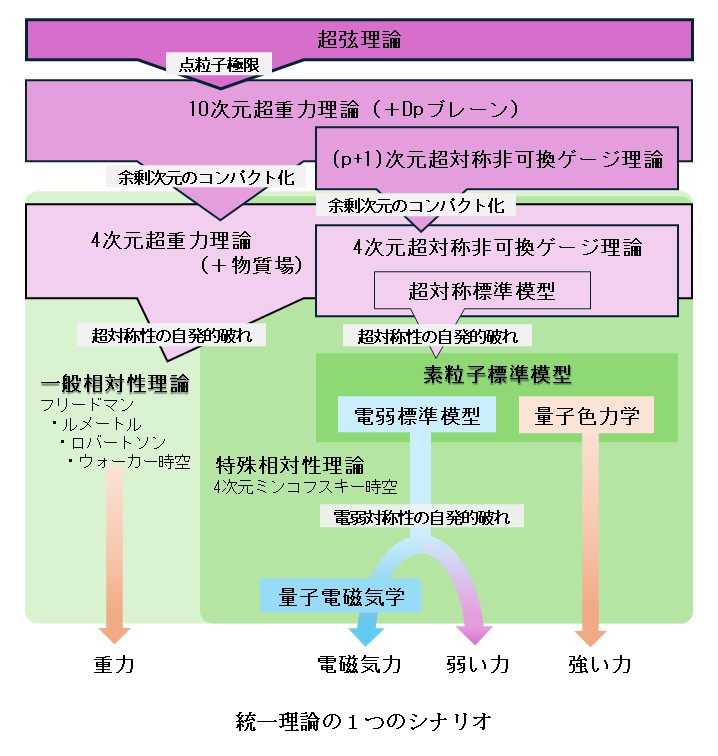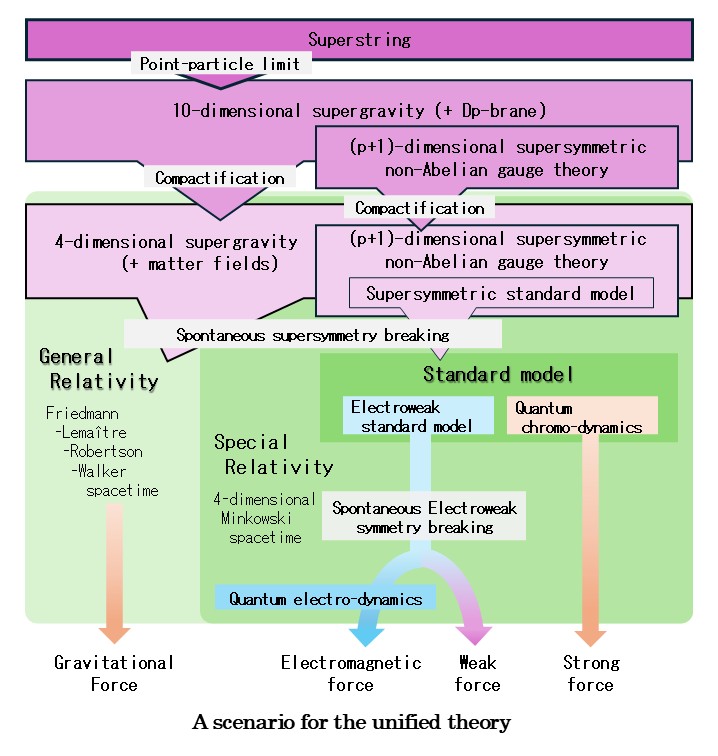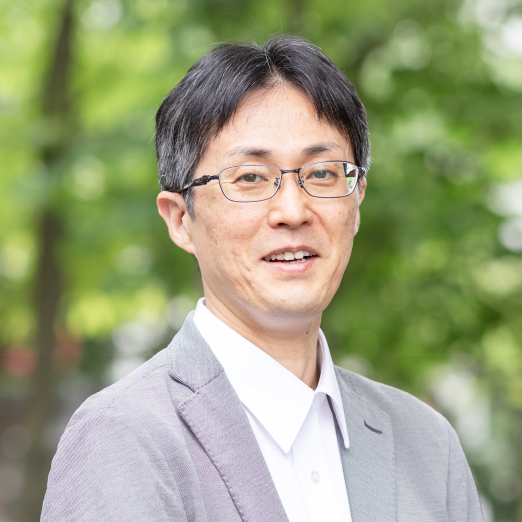専門分野
素粒子理論
究極の物理法則を求めて
研究テーマ
素粒子標準模型を超える物理 / 超対称理論・高次元時空理論 / 超重力理論・超弦理論の現象論的側面 / 素粒子統一理論
キーワード
素粒子標準模型, 場の量子論, 大統一理論, 超対称性, 超重力理論, 超弦理論
LINKS
RESEARCH OVERVIEW
研究概要
現在確認されている自然界の最も基本的な構成要素は、クォーク及びレプトンと呼ばれる物質粒子と、それらの間に働く力を媒介する各種のゲージ粒子、及び、これらに質量を与えるヒッグス粒子で、これらをまとめて素粒子と呼びます。私たちの身の回りの物質は種々の原子から構成されており、これらを拡大してみると原子核の周りを電子が周回しているという基本構造が見えますが、原子核は更に陽子や中性子の複合体です。電子はこれ以上分割できておらず、それ自体が(ニュートリノと合わせて)レプトンと呼ばれる素粒子に分類されますが、陽子と中性子は更にクォークと呼ばれる素粒子の複合体であることが分かっています。クォークやレプトンの間に働く力として電磁気力・弱い力・強い力の3種類が確認されており、これに重力を加えた4種の力がうまく働き合って我々の世界が形成されていると考えられています。重力以外の3つの力は素粒子標準模型と呼ばれるゲージ場の量子論で大変うまく記述できることが実験で確認されていますが、この標準模型にも数々の不満足な点が存在します。例えば、(量子論的)重力を含んでいないことや、素粒子の質量の値を予言できないことなどが挙げられます。
私たちの研究室では、現在知られている数少ない(矛盾のない)量子重力理論の候補の1つである、超弦理論の低エネルギー有効理論として標準模型が実現されている可能性等も視野に入れて、素粒子理論の研究、特に標準模型の背後に存在が期待される物理の理論的研究を行っています。超弦理論が素粒子の究極的統一理論だとすると、標準模型を超える物理として、高次元時空に起因する余剰次元空間の存在や、ボーズ粒子とフェルミ粒子の入れ換えの対称性(超対称性)などが予言され、これらの幾何学や力学が、観測されている素粒子の質量階層構造の決定や、量子補正に対する質量スケールの安定化等において主要な役割を担っていると考えられます。また、余剰次元や超対称性から帰結される数々の新粒子の存在は、高エネルギー物理現象や宇宙の歴史にも影響を与えると考えられ、これらの理論を研究し、高エネルギー実験や宇宙観測による検証を行うことは、現代の基礎物理学の重要な課題の1つです。

MESSAGE to STUDENTS
学生へのメッセージ
素粒子理論のコミュニティでは、大学院生も一人の自立した研究者として扱われます。「勉強」と「研究」は大きく異なることを大学院では実感すると思いますが、研究に限らずあらゆる場面で物事の本質を見極めて行動することをお薦めします。何かが起こったときにただやり過ごすのではなく、何故そうなったのか、どうしたらそうなるのかなどを良く考えてから判断する癖をつけると良いのではないでしょうか。基礎科学的な物事の見方と言えますが、様々な要素や要因が複雑に絡み合った現代社会で自分を見失わないためにも重要なことだと思います。
学歴・経歴
1998年 広島大学理学部 卒業
2003年 広島大学大学院理学研究科 修了 博士(理学)
2003年 韓国科学技術院 研究員
2005年 京都大学大学院理学研究科 研究員
2006年 日本学術振興会特別研究員(PD) 京都大学基礎物理学研究所
2008年 東北大学大学院理学研究科 助教
2009年 早稲田大学先進理工学部 准教授
2015年 現職
所属学協会
- 日本物理学会
Field of study
Theoretical Particle Physics
Quest for the ultimate laws of physics
Research Themes
Physics beyond the standard model of elementary particles / Supersymmetry and higher-dimensional spacetime / Supergravity and string phenomenology / Unified theory of elementary particles
Keywords
Standard model of elementary particles, Quantum field theory, Grand unified theory, Supersymmetry, Supergravity, Superstirng
RESEARCH OVERVIEW
The most fundamental elements of nature observed so far are elementary particles called quarks, leptons (matter particles) and gauge bosons (force mediators) as well as Higgs bosons (generating particle masses). The electron and the neutrino are classified as leptons, while the proton and the neutron are composite particles, each formed by three quarks. A quantum field theory with special local symmetries, called the standard model of elementary particles, can well describe observed high-energy phenomena within the precision of measurements. From the theoretical point of view, however, there exist many unsatisfactory points in the standard model, such as the lack of gravitational interactions, the unpredictability of the values of particle masses, and so on.
Considering such a possibility that the standard model appears as a low-energy effective theory of superstring, which is known as a promising candidate for the consistent theory of quantum gravity, we perform various theoretical and phenomenological studies for physics beyond the standard model. If superstring is the underlying theory, key ingredients will be extra-dimensions and supersymmetry, whose geometry and dynamics would play important roles for determining the observed mass hierarchies among elementary particles, stabilizing the mass scales against the quantum corrections, and so on. Furthermore, various new particles predicted by these ingredients should affect high-energy phenomena and even the history of the universe. Studying the physics behind the standard model and checking them by high-energy experiments as well as cosmological observations is one of the important subjects in fundamental physics at present.

MESSAGE to STUDENTS
In the particle theory community, graduate students are treated as independent researchers. In graduate school, you will notice that “learning” and “research” are very different. I encourage you to look at the essence of things and act accordingly, not only in research but in all aspects of life. When something happens, it will be important not to just let it go, but to think carefully about why it happened and what is causing it. This is a way of looking at things in basic science, but it may also be important in modern society, where various elements are intricately intertwined, so as not to lose sight of yourself.
Education and Career
1998: Graduated from the Faculty of Science, Hiroshima University
2003: Completed the Graduate School of Science, HIroshima University, Ph.D. (Science)
2003: Research Fellow, Korea Advanced Institute for Science and Technology
2005: Research Fellow, Graduate School of Science, Kyoto University
2006: Special Research Fellow (PD) of the Japan Society for the Promotion of Science, Yukawa Institute for Theoretical Physics, Kyoto University
2008: Assistant Professor, Graduate School of Science, Tohoku University
2009: Associate Professor, School of Advanced Science and Engineering, Waseda University
2015: Current position
Professional Memberships
- The Physical Society of Japan

